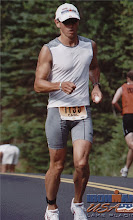 Earlier this year I came home one evening from work and saw that my copy of Runner's World Magazine had arrived. It was an edition that gave me the chills. It was an article about Bart Yasso aka the Chief Running Operating Officer of Runners World Magazine, others call him the Mayor of Running. The article talked about among many of his running adventures, his Badwater run 145 miles (to the top of Mt Whitney) but also his tough bout with Lyme disease. I thought to myself now here is a guy who can relate to me.
Earlier this year I came home one evening from work and saw that my copy of Runner's World Magazine had arrived. It was an edition that gave me the chills. It was an article about Bart Yasso aka the Chief Running Operating Officer of Runners World Magazine, others call him the Mayor of Running. The article talked about among many of his running adventures, his Badwater run 145 miles (to the top of Mt Whitney) but also his tough bout with Lyme disease. I thought to myself now here is a guy who can relate to me.Lyme disease for a runner is what sand in an engine would do.
Yasso joined Runner's World in 1987 to develop the groundbreaking Runner's World Race Sponsorship Program, creating a vehicle for Runner's World to work with over 7,000 races representing 4 million runners per year. In 2007, Bart was inducted into the Running USA Hall of Champions.
Yasso also invented the Yasso 800s, a marathon-training schedule used by thousands around the world. He is one of the few people to have completed races on all seven continents from the Antarctica marathon to the Mt. Kilimanjaro marathon. In 1987, Yasso won the U.S. National Biathlon Long Course Championship and won the Smoky Mountain Marathon in 1998. He has also completed the Ironman five times and the Badwater 146 through Death Valley. He has also cycled, unsupported and by himself, across the country twice.
When I called Bart up on the phone I was bit nervous. Bart inducted to the Running Hall of Champions did not make me feel any calmer. He didn't know me I was just a regular guy who is trying to raise Lyme awareness. When Bart picked up the phone and said "Bart" I felt already at ease. His voice was friendly. I told him what I was about to do and he was very supportive of my quest. He said "Let me know how I can help you and I will".
In his recently released autobiography "My life on the run" he recalls a visit to the doctors in 2006: (excerpt)
"....my Lyme disease returned with a vengeance, inflating my knees like basket balls. I went to see my doctor again, and he did an MRI. The scan showed degenerative joint damage in the right knee and ample evidence of arthritis. "Your running days are over,"my doc told me. "I can't run marathons anymore?" "No you can't run". I left the office in a fog.....In the end I didn't quit. I decided that however many miles more there were left in my body, I would use them judiciously, waiting for a glorious morning when it would be neither too hot or too cold, and then only running on a scenic trail. I still consider myself a lifetime runner, but only 2-3 miles at a time. I made peace with it after recognizing that running isn't how far you go but how far you have come."
Bart has been a great supporter and I had the opportunity to ask Bart a few questions of interest.
C: Bart, first I would like to thank you for becoming another Team Time For Lyme supporter. I know that you have just come out with your book "My life on the run" can you tell us a little about the book?
B: My book tells the story of runner just going out for a one mile run 31 years ago and ends about running on all seven continents and ends up with the coolest job in the world the CRO at Runner's World.
C: Being a busy man, how much do you run per week these days?
B: I do my best to run once per week 3 to 4 miles on a soft surface. It doesn't always work I haven't run a step the past 3 weeks.
C: What is your proudest running moment?
B: Getting inducted in to the Running USA hall of champions. I got inducted for all work I did for the sport not so much for my running accomplishments.
C: I know that your wife is an avid ultra marathoner. Do you have any plans to do another ultra?
B: My wife still runs lots of ultras. I haven't run an ultra in 6 years. I hope someday I can return and do one and only one ultra, Comrades.
C: Why do you think raising awareness for Lyme disease is so important?
B: I still think we don't know enough about the disease I would like to help people not contract the disease so nobody has to suffer the pain associated with Lyme.
C: Thank you Bart for supporting Time For Lyme
B: Thanks for reaching out to me I wish you the best on the NE 200!
For donations to support Lyme research (via www.timeforlyme.org) please visit: http://www.timeforlyme.org/news-one-mans-race.html
Thank you for all of your support and feel free to forward this blog to anyone you know.
Best Carl
Bart Yasso supporter of Team Time For Lyme.








